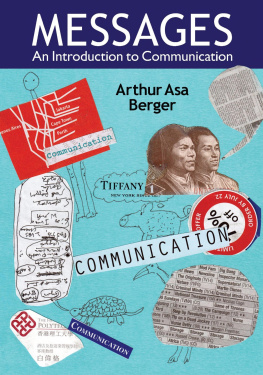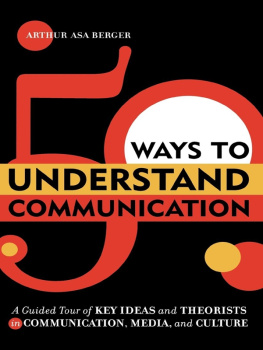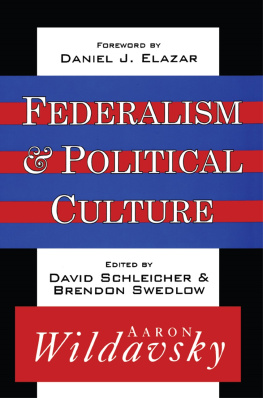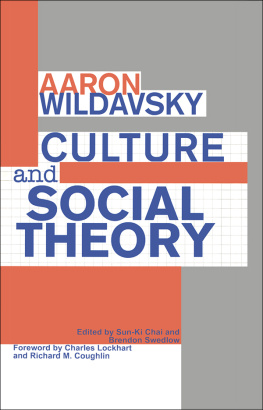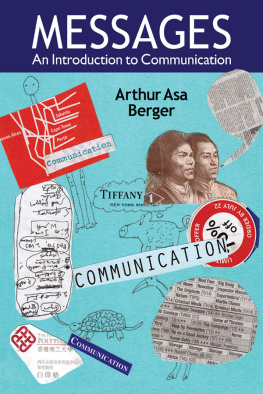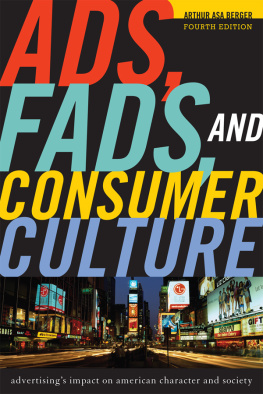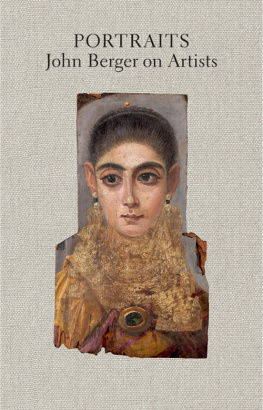First published 1990 by Transaction Publishers
Published 2017 by Routledge
2 Park Square, Milton Park, Abingdon, Oxon OX14 4RN
711 Third Avenue, New York, NY 10017, USA
Routledge is an imprint of the Taylor & Francis Group, an informa business
Copyright 1990 by Taylor & Francis.
All rights reserved. No part of this book may be reprinted or reproduced or utilised in any form or by any electronic, mechanical, or other means, now known or hereafter invented, including photocopying and recording, or in any information storage or retrieval system, without permission in writing from the publishers.
Notice:
Product or corporate names may be trademarks or registered trademarks, and are used only for identification and explanation without intent to infringe.
Library of Congress Catalog Number: 89-35247
Library of Congress Cataloging-in-Publication
Berger, Arthur Asa, 1933
Agitpop : political culture and communication theory.
p. cm. ISBN 0-88738-315-7
1. Political culture. 2. Communication. 3. Information theory.
I. Title.
JA75.7.B47 1989
306.2dc20
89-35247
CIP
ISBN 13: 978-1-4128-0645-9 (pbk)
In memory of Mulford G. SibleyAaron Wildavskys seminal work on political culture provided the framework for this book. I find his ideas extremely suggestive and in this book I carry the ball (to adopt a football metaphor) snapped to me by Aaron. He was also kind enough to review my chapter on politics and communication theory and make a number of helpful suggestions, for which I am most grateful.
I also benefitted greatly from Irving Louis Horowitzs recommendation that I add material on communication theory to my manuscript. It originally contained an introduction, explaining Wildavskys ideas about the four political cultures found in complex societies, and eight chapters on television programs, media events, films, and related subjects.
Adding material on communication theory made a great deal of sense, because I needed to offer readers a theoretical base to support my analyses. It also provided me with an opportunity to offer my readers some new theoretical work Ive done. The fact that Ive written on communication theory may be a surprise to a number of people who seem to believe that theres no theory behind my workthat I am both data free and theory free, and of course, in the best social-scientific tradition, value free.
In the last chapter of this book I offer a long autobiographical statement (perhaps confessional is a better term) dealing with my work and the theory behind it. To paraphrase St. Augustine, to San Francisco came I, burning, burning, in 1965. Since then Ive spent a good deal of time, to tip Matthew Arnold upside down, examining the worst that men (and women) have thought and said.
In addition, I owe a debt of gratitude to my students, who have played a game I developed using Aaron Wildavskys ideaswhich I call, fittingly, Aaron Wildavsky. (It probably is closer to being an exercise and will not give such games as Monopoly or Trump anything to worry about.) The students came up with some extremely interesting ideas. You will be able to read about the fruits of their labors in the first chapter of this book.
Finally, let me express my appreciation to the people at Transaction, whose high degree of professionalism and good humor have made working with them such a great pleasure.
I coined the term agitpop to focus attention on the political aspects of popular culture and the mass media. The term derives from agitprop, the bureau of agitation and propaganda created by the Russian Communists to spread Marxist ideology through films, plays, and other works of art.
Suggesting that popular culture has a political significance to it is not a startling insight, but it is one that has escaped some. Many scholars are aware of media and popular culturehow could one not bebut not particularly interested in it, considering it beneath contempt, trivial, stupid, and banalall of which it frequently is.
In the past, much of what Ive written about popular culture has been randomin the sense that it was not grounded in any theory that tied it to social and political matters except in rather vague and general terms. In this book I analyze a number of texts and other examples of popular culture and show how they relate to a theory of political culture articulated by my good friend Aaron Wildavsky.
Wildavsky suggests that people in all complex societies must find the answer to two basic questions: Who am I? (to what group do I belong) and What should I do? (what rules should I obey). This leads, he explains, to four political cultures, which he identifies as hierarchical elitist, competitive individualist, egalitarian, and fatalistic. I explain these matters in considerable detail in the first chapter.
The question I try to answer in the first part of this book is what texts (works) from the mass media and popular culture would members of each of these political cultures be drawn to and find supportive? I have selected two texts for each political culture, texts that presumably reflect the basic values and beliefs that members of each political culture would have.
I am, to a great degree, a textual analyst or critic and have focused my attention on specific programs or series or films, rather than talking in generalities about the mediathough there is some of that in Agitpop, also. Thus I have analyzed football and the Iran-Contra hearings in my chapters reflecting hierarchical elitism, dealt with MTV and the human potential movement in my chapters reflecting competitive individualism, analyzed Jewish humor and Max Headroom in my chapters reflecting egalitarianism, and written about professional wrestling and The Terminator in my chapters reflecting the fatalist orientation.
How these texts relate to each of the four political cultures is a complex question that is considered in the various chapters. I chose subjects that I thought were interesting and revealing and covered a number of different areas. Thus, the chapters deal with a sport, a political media event, humor, a new television genre, a life-style, a satirical television series, wrestling, and a film. In principle, of course, anything could be used, but I feel that the subjects I chose were particularly applicable to the matter at hand.
The second part of the book contains chapters on communication theory. One chapter deals with the relationship between Wildavskys theory and with semiotics and communication, in general. Another essay considers the focal points one might deal with in analyzing media and has a logical structure to it that is, I think, quite elegant. The content is another matter.
I am, Ive recently recognized, very binary. I create well-defined structures and operate in a very loose, free-form manner within them. I also write in two different styles: one is straightforward and essentially academic and the other is eccentric and zany. The last chapter is a case in point. It is an autobiographical statement (confessional?) on my identity as a pop culturist, my work, and my various interests and preoccupations. Some might say hang-ups and neuroses? Psychoses?



